Analysis of Fleet Management Policies for Offshore Platform Supply Vessels: The Brazilian Case
Abstract
:1. Introduction
2. PSV Fleet Management on an Operational Level
2.1. Elements of the Fleet Management System
2.1.1. Installations
- Helicopter visits: Necessary for the crew change. They are short, and their frequency varies with the number of personnel on board.
- Subsea maintenance: In some basins in Brazil, the offshore operation happens in ultra-deep water, leading to high corrosion in the production pipelines. Thus, regular pipeline maintenance is required to avoid leaks.
- Production relief: Brazil does not have an oil pipeline system to flow the oil production from the platforms to the cost. Thus, the oil production relief is conducted by oil tankers. The frequency depends on the installation storage capacity and the daily oil production rate.
- Night closed: Some installations cannot receive supply operations during the night.
- Weather conditions: under severe weather conditions, it is not possible to perform any loading or unloading at installations.
2.1.2. PSV Fleet
2.1.3. Voyages
2.1.4. Uncertainties
2.2. PSV Fleet Management Decisions and Goals
2.2.1. Fleet Management Decisions
2.2.2. Fleet Management Goals
2.3. Fleet System Dynamics
3. Fleet Management Procedures and Policies
3.1. Fleet Management Procedures
3.1.1. Vessel Control Procedure
3.1.2. Vessel Assignment to Voyages Including Cargo Selection Procedure
3.1.3. Vessel Routing and Speed Selection Procedure
3.1.4. Dynamic Voyage Re-Routing Procedure
3.2. Fleet Management Policies
- Delivery Service Level (DSL): The maximization of each voyage delivery service level together with fuel consumption reduction. However, fuel consumption reduction is not allowed if it results in delivery service level reduction.
- Fuel Consumption (FC): The minimization of fuel consumption while ensuring a required cumulative delivery service level for voyages performed under the current system state. A reduction in fuel consumption is allowed if the cumulative delivery service level is above the minimum required.
4. Analysis of the Fleet Management Policies
4.1. Case Description
- Gain in delivery service level: The gain above the minimum required delivery service level. We considered the minimum required delivery service level to be 98%, the same as the Base policy.
- Reduction in fuel consumption: Fuel consumption reduction in percentage. The fuel consumption base to calculate a reduction is the fuel consumption in Base policy.
- Number of delayed voyages: A number of voyages did not start at the planned schedule time due to a lack of available vessels.
- Total hours of delays: Total hours delayed in the planned schedule time due to a lack of available vessels.
4.2. Presentation and Analysis of Results
4.2.1. Vessel Routing and Speed Selection Procedure Impacts
4.2.2. Vessel Control Procedure Impacts
4.3. Impact on Fleet Size and Cost/Emission Reductions
5. Conclusions and Future Work
Author Contributions
Funding
Data Availability Statement
Acknowledgments
Conflicts of Interest
Abbreviations
| OSV | Offshore Supply Vessel |
| PSV | Platform Supply Vessel |
| GHG | Greenhouse Gas |
| TLP | Tension Leg Platform |
| FPSO | Floating Production Storage and Offloading Platform |
| RS | Routing and Speed Optimization |
| R | Routing Optimization |
| S | Speed Optimization |
| DSL | Delivery Service Level |
| FC | Fuel Consumption |
| KPI | Key Performance Indicator |
| CO2 | Carbon Dioxide |
Appendix A
| Policy | Fleet Size | Gain in Delivery Service Level | Reduction in Fuel Consumption | Number of Delayed Voyages | Total Hours of Delays |
|---|---|---|---|---|---|
| Base | 28 | 0 ± 0.03% | 0 ± 0.19% | 20.1 ± 5.2 | 56.36 ± 17.7 |
| R/DSL/1 | 28 | 1.85 ± 0.01% | 8.39 ± 0.21% | 0.07 ± 0.09 | 0.05 ± 0.07 |
| R/DSL/1 | 25 | 1.64 ± 0.05% | 12.38 ± 0.18% | 14 ± 4.86 | 39.96 ± 18.54 |
| S/DSL/1 | 28 | 0.23 ± 0.08% | 24.85 ± 0.43% | 19.57 ± 3.93 | 45.9 ± 12.47 |
| RS/DSL/1 | 28 | 1.88 ± 0.02% | 38.11 ± 0.21% | 11.93 ± 2.79 | 24.92 ± 6.98 |
| RS/DSL/1 | 27 | 1.78 ± 0.04% | 37.37 ± 0.39% | 18.57 ± 3.66 | 37.64 ± 9.7 |
| RS/DSL/2 | 28 | 1.92 ± 0.01% | 36.8 ± 0.3% | 1.43 ± 0.8 | 2.85 ± 2.2 |
| RS/DSL/2 | 24 | 1.39 ± 0.2% | 26.24 ± 1.05% | 11.37 ± 3.02 | 25.75 ± 8.3 |
| RS/DSL/3 | 28 | 1.94 ± 0.01% | 34.15 ± 0.3% | 0.03 ± 0.07 | 0.09 ± 0.19 |
| RS/DSL/3 | 23 | 1.8 ± 0.02% | 11.94 ± 1.04% | 14.7 ± 3.9 | 45.99 ± 15.78 |
| RS/FC/1 | 28 | 0.01 ± 0.01% | 40.81 ± 0.3% | 12.13 ± 2.33 | 24.65 ± 6.16 |
| RS/FC/2 | 28 | 0.04 ± 0.01% | 39.32 ± 0.35% | 1.7 ± 0.69 | 2.89 ± 1.75 |
| RS/FC/2 | 24 | 0.31 ± 0.12% | 27.32 ± 0.93% | 12.43 ± 2.38 | 27.83 ± 7.92 |
| RS/FC/3 | 28 | 0.32 ± 0.05% | 35.91 ± 0.51% | 0.13 ± 0.17 | 0.18 ± 0.27 |
| RS/FC/3 | 23 | 1.27 ± 0.03% | 12.71 ± 0.91% | 14.2 ± 4.31 | 42.94 ± 16.33 |
References
- Skoko, I.; Lušić, Z.; Pušić, D. Commercial and strategic aspects of the offshore vessels market. Zesz. Nauk. Akad. Morskiej Szczecinie 2020, 62, 18–25. [Google Scholar] [CrossRef]
- Aas, B.; Halskau, Ø.; Wallace, S.W. The role of supply vessels in offshore logistics. Marit. Econ. Logist. 2009, 11, 302–325. [Google Scholar] [CrossRef]
- Skoko, I.; Lušić, Z.; Sanchez-Varela, Z.; Boko, Z. Optimization model for selection of the offshore fleet structure. J. Mar. Sci. Eng. 2024, 12, 263. [Google Scholar] [CrossRef]
- Queiroz, M.M.; Mendes, A.B. Critical success factors of the Brazilian offshore support vessel industry: A flexible systems approach. Glob. J. Flex. Syst. Manag. 2020, 21, 33–48. [Google Scholar] [CrossRef]
- Skoko, I.; Jurčević, M.; Božić, D. Logistics aspect of offshore support vessels on the west Africa market. Pro.-Traf. Trans. 2013, 25, 587–593. [Google Scholar] [CrossRef]
- The Rising Cost of Labor in the Offshore Supply Vessels (OSV) Industry. Available online: https://www.spglobal.com/commodityinsights/en/ci/research-analysis/the-rising-cost-of-labor-in-the-offshore-supply-vessels-osv-in.html (accessed on 14 January 2025).
- Adland, R.; Cariou, P.; Wolff, F.C. When energy efficiency is secondary: The case of Offshore Support Vessels. Trans. Res. Part D Trans. Environ. 2019, 72, 114–126. [Google Scholar] [CrossRef]
- Psaraftis, H.N. Speed optimization versus speed reduction: Are speed limits better than a bunker levy? Marit. Econ. Logist. 2019, 21, 524–542. [Google Scholar] [CrossRef]
- Vejvar, M.; Lai, K.-H.; Lo, C.K.Y. A citation network analysis of sustainability development in liner shipping management: A review of the literature and policy implications. Marit. Policy Manag. 2019, 47, 1–26. [Google Scholar] [CrossRef]
- Silva, V.A. Deterministic and Stochastic Modeling for Planning of Platform Supply Vessels Operations in Offshore Oil and Gas Logistics. Ph.D. Thesis, Federal University of Rio de Janeiro, Rio de Janeiro, Brazil, 2023. [Google Scholar]
- Maisiuk, Y.; Gribkovskaia, I. Fleet sizing for offshore supply vessels with stochastic sailing and service times. Proc. Comp. Sci. 2014, 31, 939–948. [Google Scholar] [CrossRef]
- Kisialiou, Y.; Gribkovskaia, I.; Laporte, G. Periodic supply vessel planning under demand and weather uncertainty. INFOR 2021, 59, 411–438. [Google Scholar] [CrossRef]
- Cruz, R.; Mendes, A.B.; Bahiense, L. Schedule robustness in the periodic supply vessels planning problem with stochastic demand and travel time. Int. Tran. Oper. Res. 2024, 31, 2338–2365. [Google Scholar] [CrossRef]
- Bittencourt, G.C.; Chagas, R.D.S.; Silva, V.A.; Vianna, I.G.P.; Longhi, R.P.; Ribas, P.C.; Filho, V.J.M.F. A solution framework for the integrated problem of cargo assignment, fleet sizing, and delivery planning in offshore logistics. Comp. Ind. Eng. 2021, 161, 107653. [Google Scholar] [CrossRef]
- Evazabadian, F.; Arvan, M.; Ghodsi, R. Short-term crude oil scheduling with preventive maintenance operations: A fuzzy stochastic programming approach. Int. Trans. Oper. Res. 2019, 26, 2450–2475. [Google Scholar] [CrossRef]
- Panda, D.; Ramteke, M. Dynamic hybrid scheduling of crude oil using structure adapted genetic algorithm for uncertainty of tank unavailability. Chem. Eng. Res. Des. 2020, 159, 78–91. [Google Scholar] [CrossRef]
- Hou, Y.; Zhang, Y.; Wu, N.; Zhu, Q. Constrained multi-objective optimization of short-term crude oil scheduling with dual pipelines and charging tank maintenance requirement. Inf. Sci. 2022, 588, 381–404. [Google Scholar] [CrossRef]
- Er Raqabi, E.M.; Wu, Y.; El Hallaoui, I.; Soumis, F. Towards resilience: Primal large-scale re-optimization. Transp. Res. Part E Logist. Transp. Rev. 2024, 192, 103819. [Google Scholar] [CrossRef]
- Shaabani, H.; Hvattum, L.M.; Laporte, G.; Hoff, A. Stability metrics for a maritime inventory routing problem under sailing time uncertainty. EURO J. Transp. Logist. 2024, 13, 100146. [Google Scholar] [CrossRef]
- Dong, Y.; Maravelias, C.T.; Jerome, N.F. Reoptimization framework and policy analysis for maritime inventory routing under uncertainty. Opt. Eng. 2018, 19, 937–976. [Google Scholar] [CrossRef]
- Vianna, I.G.P.; Filho, V.J.M.F. Fleet reduction policies analysis using heuristic and discrete-event simulation. In Proceedings of the LI Simpósio Brasileiro de Pesquisa Operacional, Limeira, Brazil, 2–6 September 2019; Available online: https://proceedings.science/sbpo/sbpo-2019/trabalhos/analise-de-diferentes-politicas-de-reducao-da-frota-com-o-uso-de-heuristica-e-si?lang=pt-br (accessed on 14 February 2025).
- Vianna, I.G.P.; Ribas, P.C.; Filho, V.J.M.F. Analysis of strategies to solve the pick-up and delivery problem with fixed routes and heterogeneous fleet. In Proceedings of the LII—Simpósio Brasileiro de Pesquisa Operacional, João Pessoa, Brazil, 3–5 November 2020; Available online: https://proceedings.science/sbpo/sbpo-2020/trabalhos/analise-de-diferentes-estrategias-para-o-problema-de-coleta-e-entrega-com-rotas?lang=pt-br (accessed on 14 February 2025).
- Chagas, R.D.S.; Filho, V.J.M.F. Relax-and-fix heuristics for the multi-commodity psv planning problem with order selection and time window decisions. Comp. Ind. Eng. 2023, 177, 109040. [Google Scholar] [CrossRef]
- Ribeiro, L.S. An approximated dynamic programming model for the supply vessel fleet sizing problem. Comp. Oper. Res. 2024, 163, 106510. [Google Scholar] [CrossRef]
- Seixas, M.P.; Mendes, A.B.; Barretto, M.R.P.; Cunha, C.B.; Brinati, M.A.; Cruz, R.E.; Wu, Y.; Wilson, P.A. A heuristic approach to stowing general cargo into platform supply vessels. J. Oper. Res. Soc. 2015, 67, 148–158. [Google Scholar] [CrossRef]
- Mardaneh, E.; Lin, Q.; Loxton, R.; Wilson, N. Cargo scheduling decision support for offshore oil and gas production: A case study. Opt. Eng. 2017, 18, 991–1008. [Google Scholar] [CrossRef]
- Eskandari, H.; Mahmoodi, E. A simulation-based multi-objective optimization study of the fleet sizing problem in the offshore industry. Marit. Econ. Logist. 2016, 18, 436–457. [Google Scholar] [CrossRef]
- Yamashita, D.; da Silva, B.J.V.; Morabito, R.; Ribas, P.C. A multi-start heuristic for the ship routing and scheduling of an oil company. Comp. Ind. Eng. 2019, 136, 464–476. [Google Scholar] [CrossRef]
- Norlund, E.K.; Gribkovskaia, I.; Laporte, G. Supply vessel planning under cost, environment and robustness considerations. Omega 2015, 57, 271–281. [Google Scholar] [CrossRef]
- Norlund, E.K.; Gribkovskaia, I. Reducing emissions through speed optimization in supply vessel operations. Trans. Res. Part D Trans. Environ. 2013, 23, 105–113. [Google Scholar] [CrossRef]
- Ulsrud, K.P.; Vandvik, A.H.; Ormevik, A.B.; Fagerholt, K.; Meisel, F. A time-dependent vessel routing problem with speed optimization. Eur. J. Oper. Res. 2022, 303, 891–907. [Google Scholar] [CrossRef]
- Psaraftis, H.N.; Kontovas, C.A. Speed models for energy-efficient maritime transportation: A taxonomy and survey. Trans. Res. Part C Emerg. Technol. 2013, 26, 331–351. [Google Scholar] [CrossRef]
- Pereda, P.C.; Lucchesi, A. Alternative frameworks for cost-effectiveness analysis of environmental policies in maritime transport. Marit. Econ. Logist. 2022, 24, 630–650. [Google Scholar] [CrossRef]
- Castro, P.M. Maritime inventory routing with speed optimization: A MIQCP formulation for a tanker fleet ser-vicing FPSO units. Comp. Chem. Eng. 2025, 192, 108889. [Google Scholar] [CrossRef]
- Hua, R.; Yin, J.; Wang, S.; Han, Y.; Wang, X. Speed optimization for maximizing the ship’s economic benefits considering the Carbon Intensity Indicator (CII). Ocean Eng. 2024, 293, 116712. [Google Scholar] [CrossRef]
- Santos, I.M.; Hamacher, S.; Oliveira, F. A data-driven optimization model for the workover rig scheduling problem: Case study in an oil company. Comp. Chem. Eng. 2023, 170, 108088. [Google Scholar] [CrossRef]
- Kromodihardjo, S.; Kromodihardjo, E.S. Modeling of well service and workover to optimize scheduling of oil well maintenance. Appl. Mech. Mater. 2016, 836, 311–316. [Google Scholar] [CrossRef]
- Halvorsen-Weare, E.E.; Fagerholt, K.; Rönnqvist, M. Vessel routing and scheduling under uncertainty in the liquefied natural gas business. Comp. Ind. Eng. 2013, 64, 290–301. [Google Scholar] [CrossRef]
- Raknes, N.T.; Ødeskaug, K.; Stålhane, M.; Hvattum, L.M. Scheduling of maintenance tasks and routing of a joint vessel fleet for multiple offshore wind farms. J. Mar. Sci. Eng. 2017, 5, 11. [Google Scholar] [CrossRef]
- Cunha, V.; Santos, I.M.; Pessoa, L.; Hamacher, S. An ILS heuristic for the ship scheduling problem: Application in the oil industry. Int. Trans. Oper. Res. 2020, 27, 197–218. [Google Scholar] [CrossRef]
- Vieira, B.S.; Ribeiro, G.M.; Bahiense, L.; Cruz, R.; Mendes, A.B.; Laporte, G. Exact and heuristic algorithms for the fleet composition and periodic routing problem of offshore supply vessels with berth allocation decisions. Eur. J. Oper. Res. 2021, 295, 908–923. [Google Scholar] [CrossRef]
- Cruz, R.; Mendes, A.B.; Bahiense, L.; Wu, Y. Integrating berth allocation decisions in a fleet composition and periodic routing problem of platform supply vessels. Eur. J. Oper. Res. 2019, 275, 334–346. [Google Scholar] [CrossRef]
- Pinto, G.L.; Vitorugo, L.R.; Rosa, R.A.; Arpini, B.P.; Caprini, L.A. Planning the transport of loads to oil platforms considering the arrangement of the loads on the ship’s deck. Comput. Ind. Eng. 2018, 119, 289–300. [Google Scholar] [CrossRef]
- Offshore Rig Ocean Nomad in Cromarty Firth. Available online: https://www.geograph.org.uk/photo/5100335 (accessed on 14 February 2025).
- File:FPSO OSX-1.jpg. Available online: https://commons.wikimedia.org/wiki/File:FPSO_OSX-1.jpg (accessed on 14 February 2025).
- File:OSV Storm.jpg. Available online: https://commons.wikimedia.org/wiki/File:OSV_Storm.jpg (accessed on 14 February 2025).
- File:OSV Fantasy Island.jpg. Available online: https://commons.wikimedia.org/wiki/File:OSV_Fantasy_Island.jpg (accessed on 14 February 2025).
- Zhou, C.; Ma, N.; Cao, X.; Lee, L.H.; Chew, E.P. Classification and literature review on the integration of simulation and optimization in maritime logistics studies. IISE Trans. 2021, 53, 1157–1176. [Google Scholar] [CrossRef]
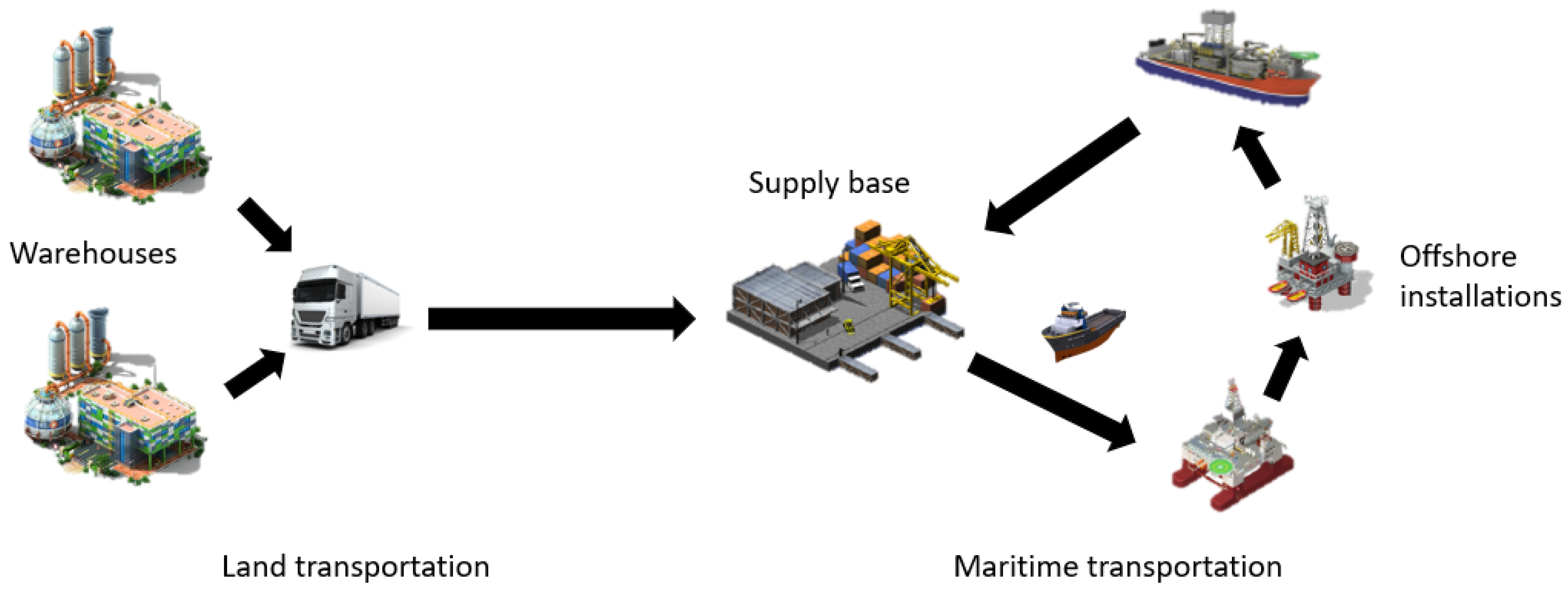
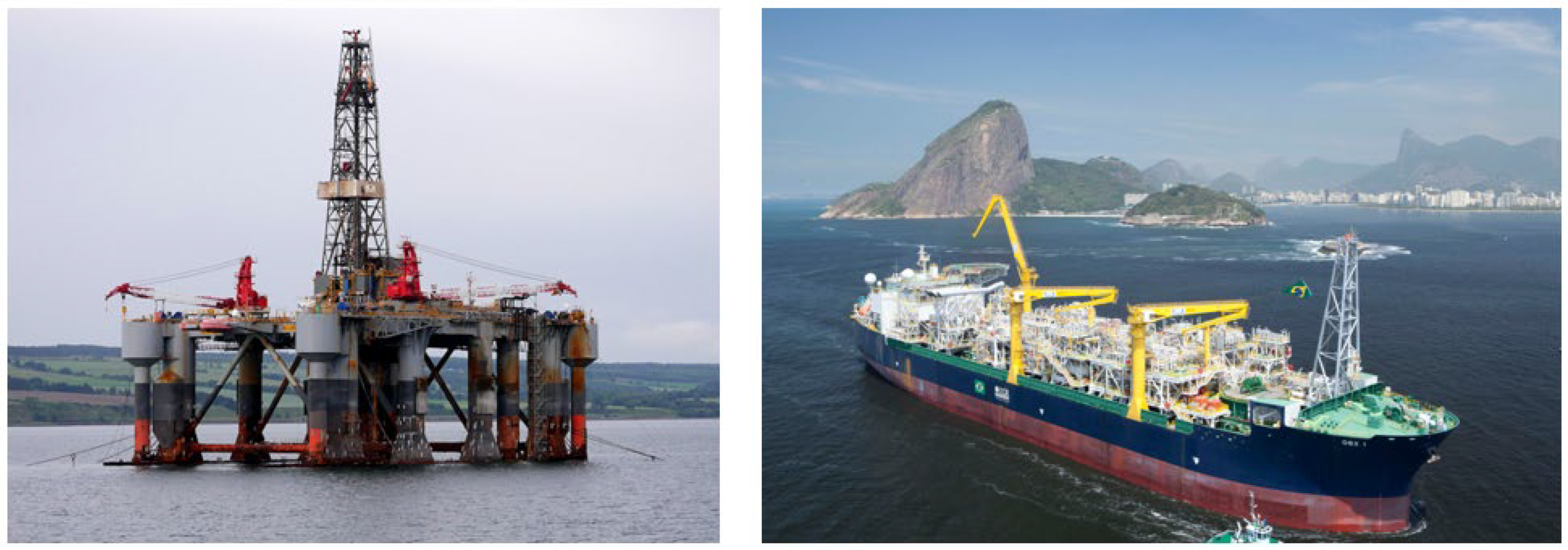
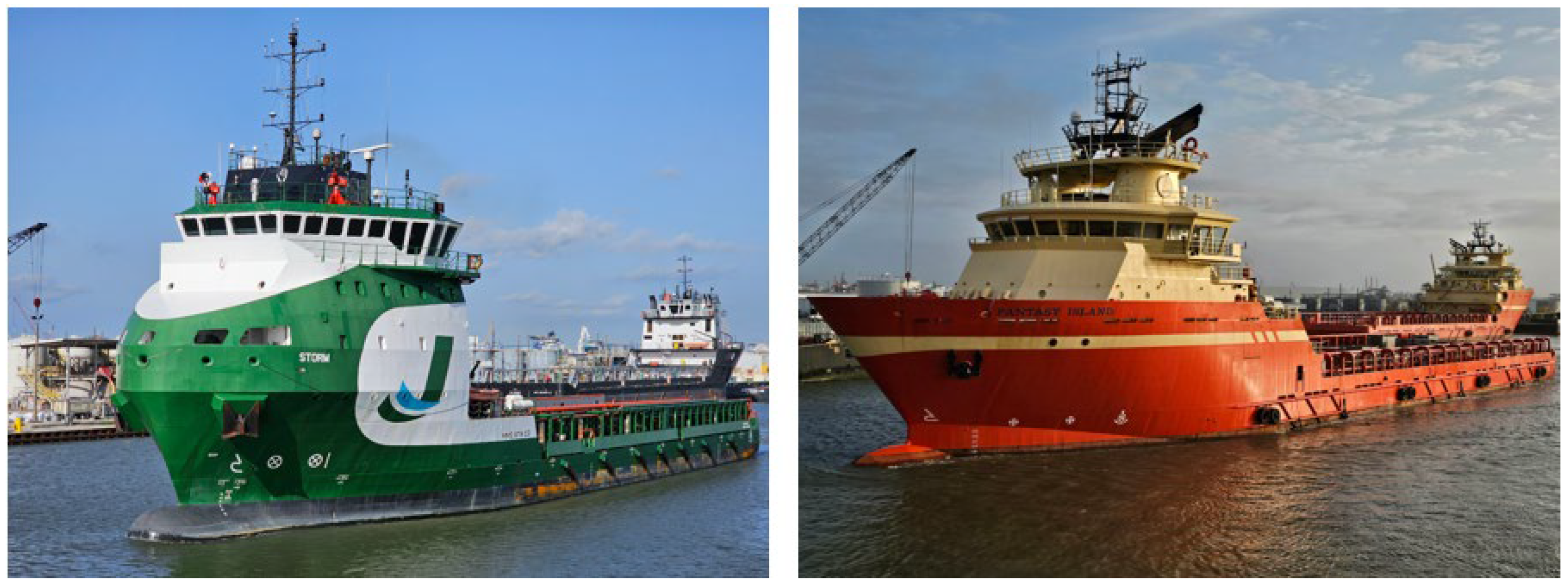

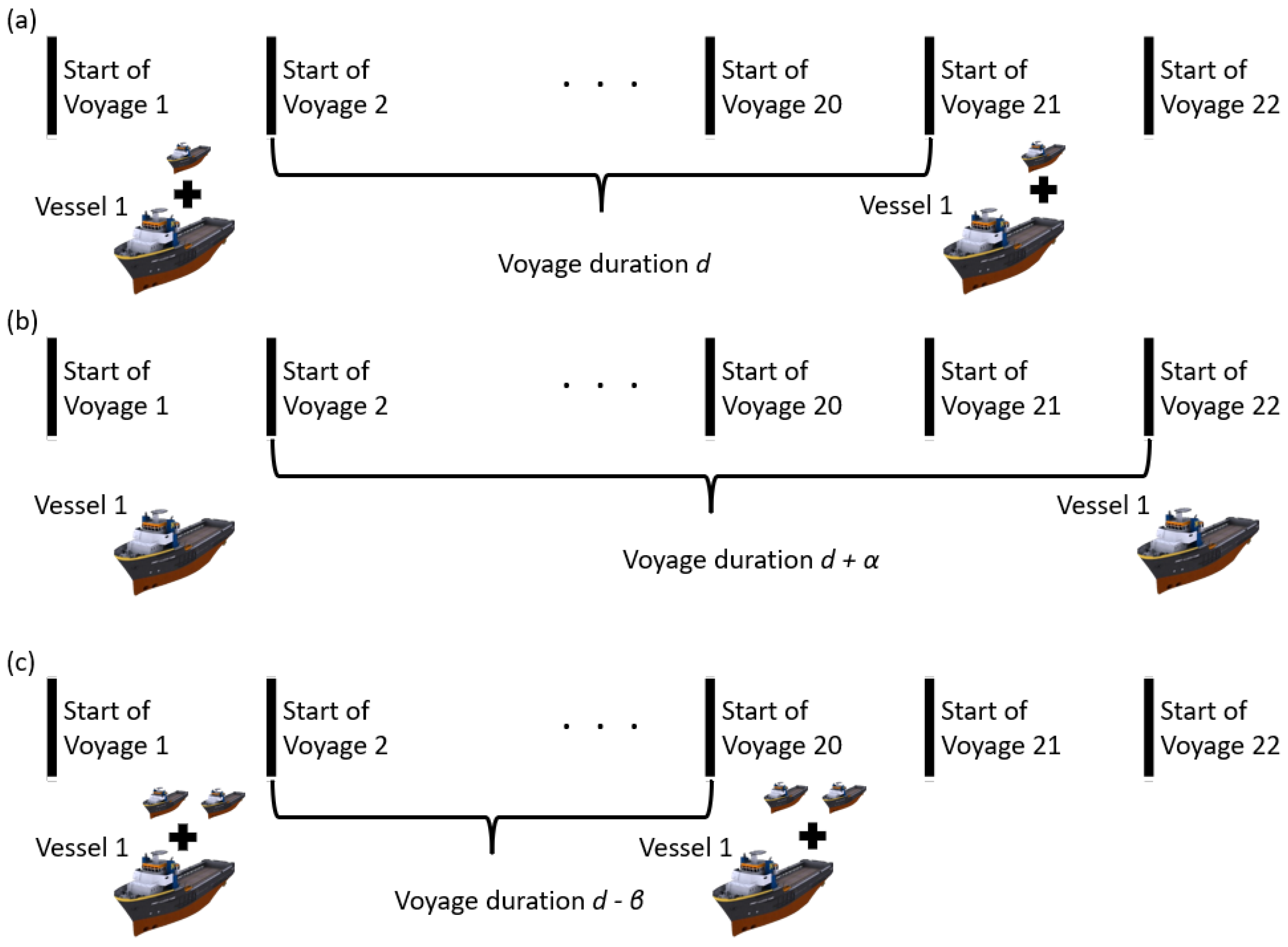
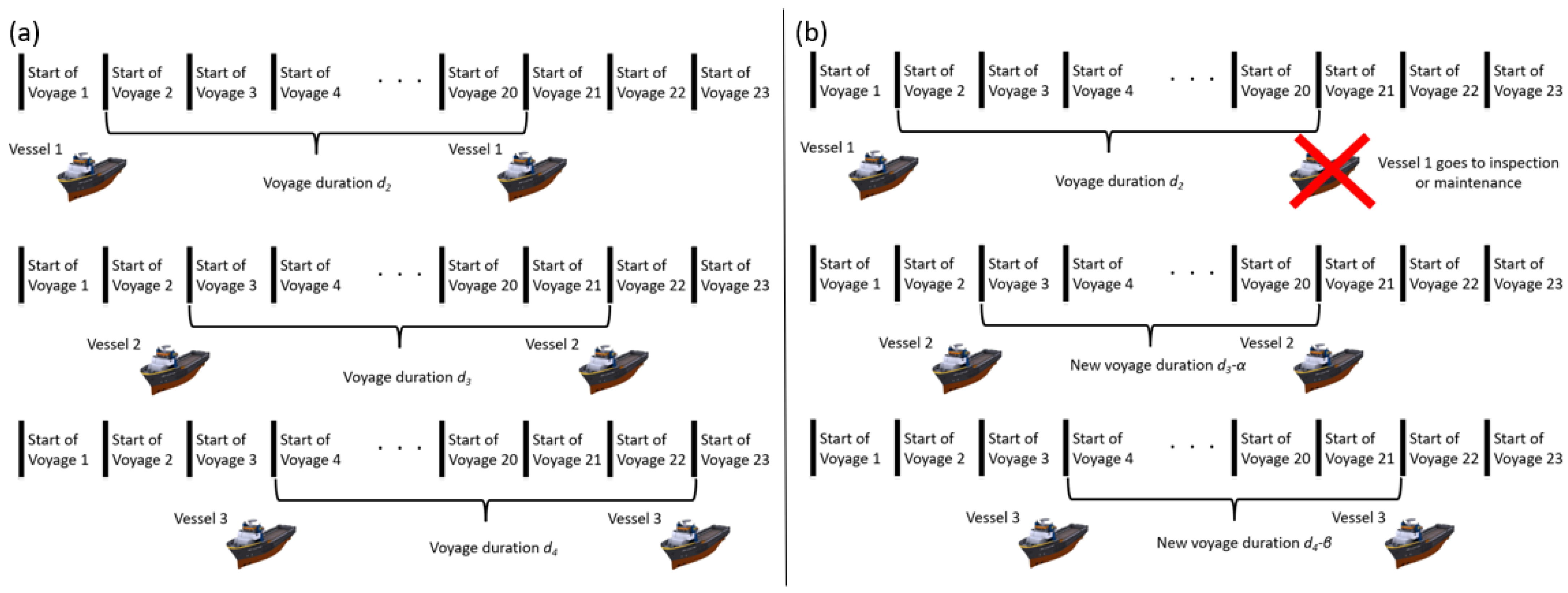
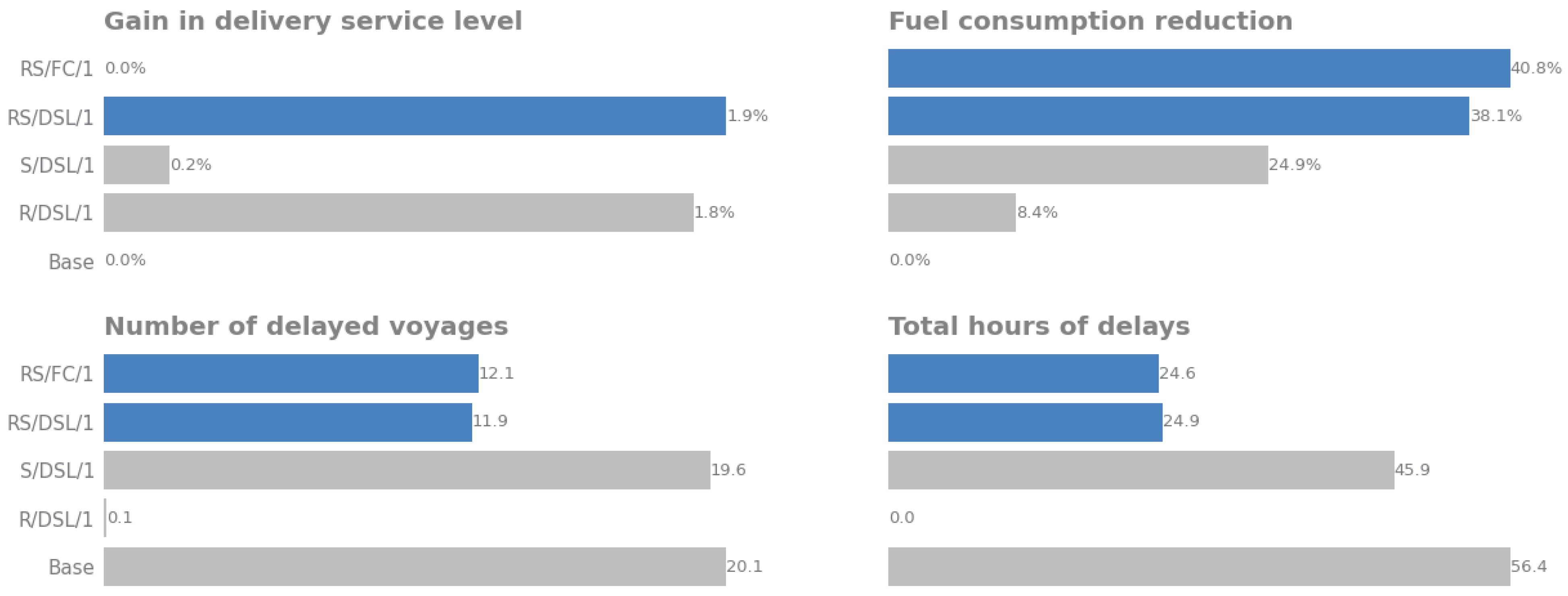
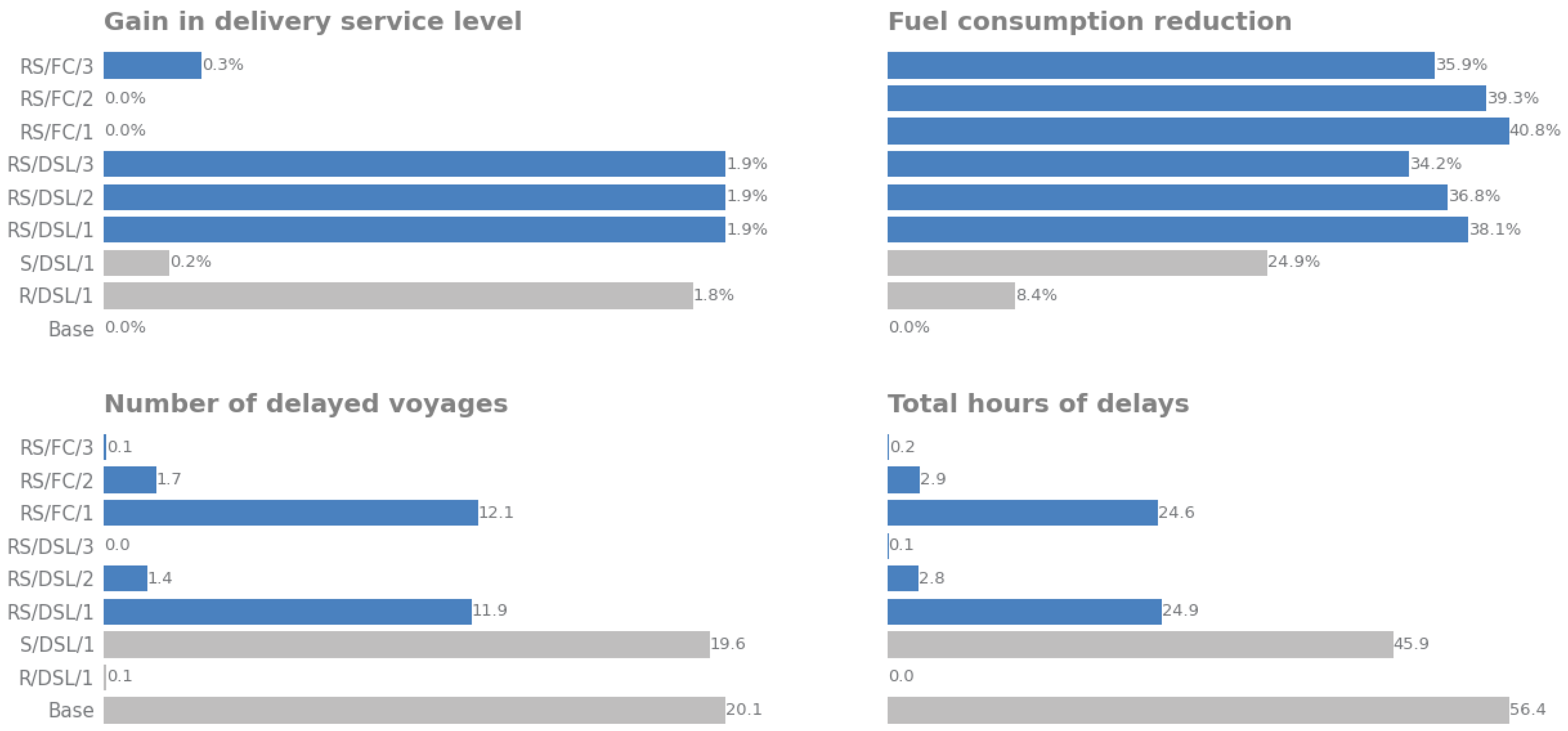
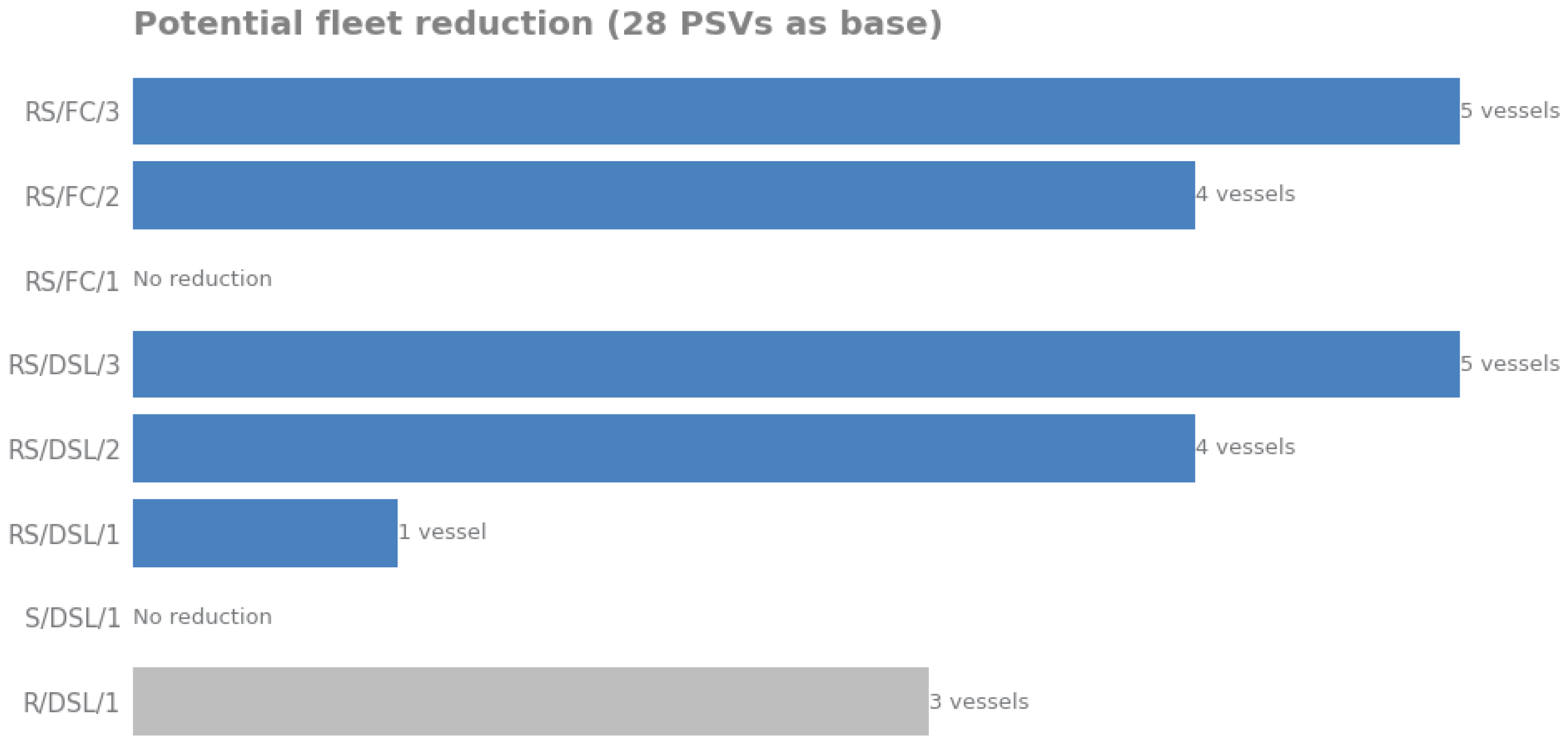
| Policy Name | Sailing Speed | Route | Goal | Minimum Number of Available Vessels |
|---|---|---|---|---|
| Base | Fixed | Fixed | - | - |
| R/DSL/1 | Fixed | Optimized | DSL | 1 |
| S/DSL/1 | Optimized | Fixed | DSL | 1 |
| RS/DSL/1 | Optimized | Optimized | DSL | 1 |
| RS/DSL/2 | Optimized | Optimized | DSL | 2 |
| RS/DSL/3 | Optimized | Optimized | DSL | 3 |
| RS/FC/1 | Optimized | Optimized | FC | 1 |
| RS/FC/2 | Optimized | Optimized | FC | 2 |
| RS/FC/3 | Optimized | Optimized | FC | 3 |
| Policy | Largest Fleet Size Reduction | Potential Hiring Cost Reduction (%) | Potential Fuel Cost Reduction (%) |
|---|---|---|---|
| R/DSL/1 | 3 | 10.7 | 12.4 |
| S/DSL/1 | 0 | 0 | 24.9 |
| RS/DSL/1 | 1 | 3.4 | 37.5 |
| RS/DSL/2 | 4 | 14.3 | 26.2 |
| RS/DSL/3 | 5 | 17.9 | 11.9 |
| RS/FC/1 | 0 | 0 | 40.8 |
| RS/FC/2 | 4 | 14.3 | 27.3 |
| RS/FC/3 | 5 | 17.9 | 12.7 |
Disclaimer/Publisher’s Note: The statements, opinions and data contained in all publications are solely those of the individual author(s) and contributor(s) and not of MDPI and/or the editor(s). MDPI and/or the editor(s) disclaim responsibility for any injury to people or property resulting from any ideas, methods, instructions or products referred to in the content. |
© 2025 by the authors. Licensee MDPI, Basel, Switzerland. This article is an open access article distributed under the terms and conditions of the Creative Commons Attribution (CC BY) license (https://creativecommons.org/licenses/by/4.0/).
Share and Cite
Vianna, I.G.P.; Ribas, P.C.; Martins Ferreira Filho, V.J.; Gribkovskaia, I. Analysis of Fleet Management Policies for Offshore Platform Supply Vessels: The Brazilian Case. J. Mar. Sci. Eng. 2025, 13, 686. https://doi.org/10.3390/jmse13040686
Vianna IGP, Ribas PC, Martins Ferreira Filho VJ, Gribkovskaia I. Analysis of Fleet Management Policies for Offshore Platform Supply Vessels: The Brazilian Case. Journal of Marine Science and Engineering. 2025; 13(4):686. https://doi.org/10.3390/jmse13040686
Chicago/Turabian StyleVianna, Igor Girão Peres, Paulo Cesar Ribas, Virgílio José Martins Ferreira Filho, and Irina Gribkovskaia. 2025. "Analysis of Fleet Management Policies for Offshore Platform Supply Vessels: The Brazilian Case" Journal of Marine Science and Engineering 13, no. 4: 686. https://doi.org/10.3390/jmse13040686
APA StyleVianna, I. G. P., Ribas, P. C., Martins Ferreira Filho, V. J., & Gribkovskaia, I. (2025). Analysis of Fleet Management Policies for Offshore Platform Supply Vessels: The Brazilian Case. Journal of Marine Science and Engineering, 13(4), 686. https://doi.org/10.3390/jmse13040686






